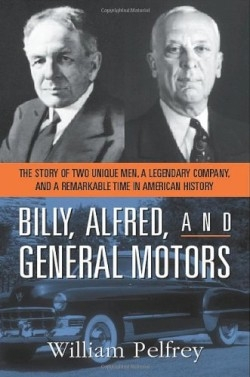Billy, Alfred, and General Motors
The Story of Two Unique Men a Legendary Company and a Remarkable Time in American History
On September 16, 1908, the New York Times ran a lead business news story in which the White Star Line announced that construction was beginning on the world’s largest steamship, the Titanic. On the same day, another announcement received little fanfare, but would forever change the automobile industry: the filing of the papers of a new corporation called General Motors.
This book tells the story of two important figures in GM history, and the important differences in their personalities and characters: William “Billy” Crapo Durant (the dauntless, energetic gambler and creative force who filed GM’s papers) and Alfred Pritchard Sloan (a master of organization and administration, who in 1923 was elected GM president and remained chief for thirty-three years). Despite Sloan’s bestseller My Years with General Motors, Durant is the focus of this volume, with his ideas that were ahead of their time and his continual lookout for the next opportunity. The reader learns little about Sloan other than the fact that Durant pushed him, and quite a few others, a bit too far with his reckless management style.
The author tells an amazing story, previously largely untold, as Durant was never able to organize an autobiography before his death. Pelfrey’s writing causes the reader to keep wondering what glowing achievement Durant will next snatch from the jaws of catastrophe. Sloan only becomes the central subject in the last pages of the book, when he gathers up the many sections of GM that Durant brought together, and turns them into the model corporation of the century.
Pelfrey has an intimate knowledge of General Motors, having worked there for fifteen years as director of executive communications. He was also a journalist with the New York Times, Atlantic Monthly, and New Republic and now works independently as an executive speechwriter, communications advisor, and author; his book The Big V won him a National Endowment for the Arts Fellowship and a nomination for the National Book Award.
Here, he explains that Durant started as a master carriage builder in Flint, and Sloan headed a ball-bearing business. Durant, who knew nothing about how automobiles worked, brought together a who’s who of the nascent automobile industry in the early twentieth century.
He picked winners: David Dunbar Buick’s unique engine design, with a powerful overhead valve, remained at the heart of what became a whole group of companies. Ransom Olds, explains Pelfrey, “laid out the product strategy and focus that would prove to be the key to success not only in autos but hundreds of other businesses, including computers, throughout the twentieth century and beyond.” Henry Leland’s Cadillac retained its reputation for quality and reliability. Charles Kettering’s 1911 introduction of the electric starter motor in the Cadillac revolutionized the industry. Durant also brought Delco and Frigidaire to GM.
Chevrolet was Durant’s answer to Ford’s “car for the masses,” as well as GM’s most famous, enduring brand. He hired Arthur and Louis Chevrolet, already famous for their auto racing exploits; the brothers eventually lent their name to the company, but little else. Walter Chrysler eventually left to found his own automaker. Of the scores of companies that Durant assembled, only a handful survived as part of GM.
Despite having to be bailed out for his failures three times, Durant never quit. Included among his many coups was the avoidance of having these early car companies brought under the control of banking interests like J.P. Morgan. GM’s reins were finally taken from Durant in 1920 for the last time. No more backers remained for him to approach for cash. Just before he suffered a stroke in 1942, Durant still had a plan: to build community bowling alleys with nearby restaurants with food ordered from inside the cars.
Readers are liable to feel like part of this story, since the many different lines and styles of GM cars came to identify the different social strata of American citizens. Families were defined by whether they owned that Chevrolet, Buick, Pontiac, or Cadillac, especially from an economic standpoint, as each division was purposely marketed to those groups of American consumers.
A reduction in the length and frequency of quotes in the early pages of this book would have improved the continuity of the narrative. Overall, however, this is the illuminating, yet little known, saga of the clash between the eternal dreamers, inventors, tinkerers, and salesmen at the dawn of the twentieth century, represented by Durant, and the logical, corporate, “big picture” leader that Sloan personified.
Disclosure: This article is not an endorsement, but a review. The publisher of this book provided free copies of the book to have their book reviewed by a professional reviewer. No fee was paid by the publisher for this review. Foreword Reviews only recommends books that we love. Foreword Magazine, Inc. is disclosing this in accordance with the Federal Trade Commission’s 16 CFR, Part 255.

